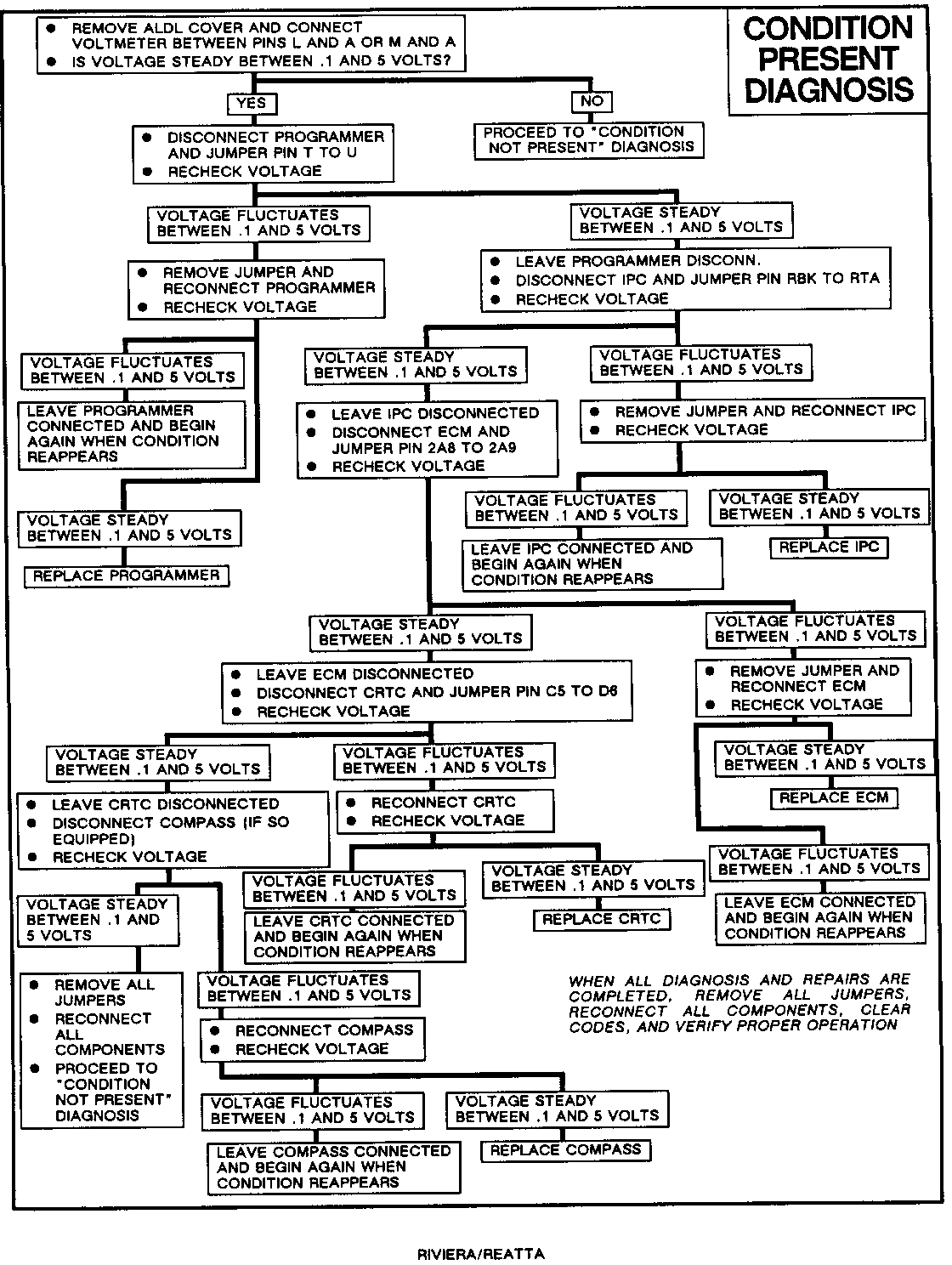SERVICE MANUAL DIAGNOSTIC PROCEDURE

MODELS/YEARS: 1986-88 TORONADO
Some 1986-88 Toronados may experience intermittent setting of data line codes E047, B334, B335, B336 and/or B337. These may all be set at one time or in any combination. Single codes should be diagnosed using the appropriate trouble tree in the service manual.
Some comments may be received on the following conditions when these codes are set:
- IPC and/or the ECC flashes on and off or bright/dim - Fuel gage flashes "E" - Trip odometer resets to 0 - ECC switches to full heat at high blower speed out the front defrost ducts - Erroneous gage displays appear on the IPC - ECC panel does not respond to pressing of buttons - DIC may display SYSTEM PROBLEM - Speedometer reads 0 while driving
This condition may be caused by either a damaged data line circuit or one of the components connected to the data line.
To repair this condition, monitor the data line voltage at the Assembly Line Data Link (ALDL) connector during the condition. Do this by removing the ALDL connector cover and probing cavities A (ground) and L (serial data), or A (ground) and M (serial data) with the leads of a digital volt-ohm meter (DVOM) set on the 20 volt scale.
The voltage reading should continually fluctuate from .1 to 5 volts on a normally operating serial data line.
If the serial data line has been shorted to ground, the voltage at the ALDL will be 0 V. if it has been shorted to voltage, it will be above 5 V. If the voltage reading is 0 V or above 5 V, inspect data line circuits between each component for both continuity to ground and for a short to voltage. Repair any open circuits, shorts to voltage, or shorts to ground and check for reoccurrence of data line codes.
If one of the components on the serial data line is affecting the data line voltage, the serial data voltage at the ALDL connector will be a steady value anywhere between .1 and 5 volts (e.g., 2.7 V, 3.5 V, etc.). To determine which of the components is causing the condition, it is necessary to try and isolate the component using the following CONDITION PRESENT DIAGNOSIS chart. (Refer to Figure 1)
CONDITION NOT PRESENT
If the condition can not be duplicated on the vehicle during diagnosis, follow procedure below:
1. Make sure that the grounds on the block near the starter solenoid, and on the fender near the battery, are clean and tight. Make certain there are star washers on the stud and that the studs are free of corrosion.
2. Check if the BCM EPROM and EEPROM and ECM CALPAK and PROM have been properly inserted into their respective sockets. Inspect components for bent or damaged legs.
3. Make sure both BCM and ECM have the correct and most up to date PROM's for that model year.
4. If the source of the intermittent problem has not been found and the intermittent condition persists:
A. Verify good connections at the following components. Check each connection for proper latching and pins seated in the connector.
B. Replace the following components, one at a time, checking for reoccurrence of the intermittent condition after each component replacement. Follow the order listed. The order listed represents most likely to least likely cause of a multiple communications code condition:
- ECC Control Panel Assembly - BCM - ECC Programmer - ECM - Central Power Supply (CPS) - BCM EPROM - IPC - Chime Module (on 1986 and 1987 models only) - ECM CALPAK or MEM-CAL - BCM EEPROM
For warranty purposes, refer to the Labor Time Guide.




General Motors bulletins are intended for use by professional technicians, not a "do-it-yourselfer". They are written to inform those technicians of conditions that may occur on some vehicles, or to provide information that could assist in the proper service of a vehicle. Properly trained technicians have the equipment, tools, safety instructions and know-how to do a job properly and safely. If a condition is described, do not assume that the bulletin applies to your vehicle, or that your vehicle will have that condition. See a General Motors dealer servicing your brand of General Motors vehicle for information on whether your vehicle may benefit from the information.
